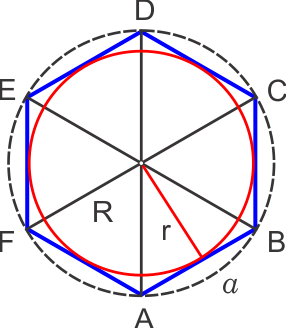Geometry
Polygons
Regular Hexagon
A regular hexagon is both equilateral and equiangular, which means each side has the same length, and all the internal angles are equal to 120°.

Suppose the side of the hexagon is a, then the length of the diagonal \(AC =\sqrt 3 a\) and that of the main diagonal \(AD = 2a\). \(\angle ABC = {120^o}\) and \(\angle ACD = {90^o}\)
Area of a Regular Hexagon
As we can see in the diagram, each internal angle is 120°, and the hexagon can be divided into 6 identical equilateral triangles, each with a vertex at O and side \(a\).

Therefore, the side of each triangle is \(a\). The area of the hexagon is 6 times the area of one triangle. Area of regular hexagon is:\[ \bbox[5px, border:1px solid blue]{6\left( \frac{\sqrt{3}}{4}a^2 \right) = \frac{3\sqrt{3}}{2}a^2} \]
Diagonals of a Regular Hexagon
Diagonals of any polygons are the lines, other than the sides, which are formed by joining the vertices. Since a hexagon has 6 vertices, there are a total of \(^{\rm{6}}{{\rm{C}}_{\rm{2}}} = 15\) lines, out of which 6 are sides of the polygon. So, there are \(^{\rm{6}}{{\rm{C}}_{\rm{2}}} -6=9\) diagonals. The general formula to calculate the number of diagonals in any convex polygon is \[ \bbox[5px, border:1px solid blue]{^n\mathrm{C}_2 - n = \frac{n(n - 3)}{2}} \]
Inscribed and Circumscribed Circles for a Regular Hexagon
For a regular hexagon with side length \(a\), both an inscribed circle (incircle) and a circumscribed circle (circumcircle) can be perfectly drawn due to the symmetry and equilateral properties of the hexagon.

The inscribed circle of a hexagon is the largest circle that fits entirely within the hexagon, touching all six sides. The radius \(r\) of the inscribed circle of a regular hexagon can be derived using the relationship between the side length and the distance from the center to the midpoint of a side. In a regular hexagon, this is also the radius of the incircle.\[\bbox[5px, border:1px solid blue]{ r = \frac{\sqrt{3}}{2}a }\]
The circumscribed circle of a hexagon is the smallest circle that contains the entire hexagon, touching all six vertices. The radius \(R\) of the circumscribed circle of a regular hexagon can be calculated as the distance from the center of the hexagon to any of its vertices. For a regular hexagon, the radius of the circumcircle is equal to the side length \(a\).\[\bbox[5px, border:1px solid blue]{ R = a }\]
Relationship Between \(r\) and \(R\):
The radius of the incircle \(r\) and the radius of the circumcircle \(R\) of a regular hexagon are related by the ratio:\[\bbox[5px, border:1px solid blue]{ \frac{r}{R} = \frac{\frac{\sqrt{3}}{2}a}{a} = \frac{\sqrt{3}}{2}}\]
This ratio shows that the radius of the incircle is \(\frac{\sqrt{3}}{2}\) times the radius of the circumcircle.
The area of the inscribed circle \(A_{\text{incircle}}\) and the area of the circumscribed circle \(A_{\text{circumcircle}}\) can also be compared:\[A_{\text{incircle}} = \pi r^2 = \pi \left(\frac{\sqrt{3}}{2}a\right)^2 = \frac{3\pi a^2}{4}\]\[A_{\text{circumcircle}} = \pi R^2 = \pi a^2\] The ratio of the areas is:\[\bbox[5px, border:1px solid blue]{\frac{A_{\text{incircle}}}{A_{\text{circumcircle}}} = \frac{\frac{3\pi a^2}{4}}{\pi a^2} = \frac{3}{4}}\] This ratio indicates that the area of the incircle is \(\frac{3}{4}\) the area of the circumcircle.
Lines of symmetry in a Regular Hexagon
A line of symmetry is a line that divides a figure into two halves such that one half is the mirror image of the other half. There can be more than one line of symmetry in a shape. The line of symmetry can be in any direction: horizontal, vertical, diagonal, etc.
A regular hexagon with six equal sides has six lines of symmetry, as shown in the diagram where each line is numbered from 1 to 6.

Area of a regular polygon
Area of any regular polygon whose side is \(a\),
=\(\frac{{n{a^2}}}{4}\cot \left( {\frac{{180}}{n}} \right)\)